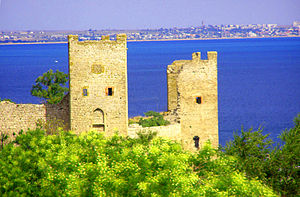
The Golden Horde, self-designated as Ulug Ulus, was originally a Mongol and later Turkicized khanate established in the 13th century and originating as the northwestern sector of the Mongol Empire. With the division of the Mongol Empire after 1259, it became a functionally separate khanate. It is also known as the Kipchak Khanate or as the Ulus of Jochi, and it replaced the earlier, less organized Cuman–Kipchak confederation.
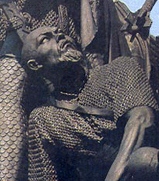
Mamai was a powerful Mongol military commander of the Golden Horde. Contrary to popular misconception, he was not a khan (king), but was a kingmaker for several khans, and dominated parts or all of the Golden Horde for a period of almost two decades in the 1360s and 1370s. Although he was unable to stabilize central authority during the war of succession known as the Great Troubles, Mamai remained a remarkable and persistent leader for decades, while others came and went in rapid succession. His defeat in the Battle of Kulikovo marked the beginning of the decline of the Horde, as well as his own rapid downfall.

Feodosia, also called in English Theodosia, is a town on the Crimean coast of the Black Sea. Feodosia serves as the administrative center of Feodosia Municipality, one of the regions into which Crimea is divided. During much of its history, the city was a significant settlement known as Caffa or Kaffa. According to the 2014 census, its population was 69,145.

The Republic of Genoa was a medieval and early modern maritime republic from the years 1099 to 1797 in Liguria on the northwestern Italian coast. During the Late Middle Ages, it was a major commercial power in both the Mediterranean Sea and the Black Sea. Between the 16th and 17th centuries, it was one of the major financial centers in Europe.

Sultan Giyasuddin Muhammad Uzbek Khan, better known as Uzbeg, Uzbek or Ozbeg (1282–1341), was the longest-reigning khan of the Golden Horde (1313–1341), under whose rule the state reached its zenith. He was succeeded by his son Tini Beg. He was the son of Toghrilcha and grandson of Mengu-Timur, who had been khan of the Golden Horde from 1267 to 1280.

Gazaria was the name given to the colonial possessions of the Republic of Genoa in Crimea and around the Black Sea coasts in the territories of the modern regions of Russia, Ukraine and Romania, from the mid-13th century to the late 15th century. The Genoese rule was represented by the Consul, and the capital of the Gazaria was the city of Kaffa in the Crimean peninsula.
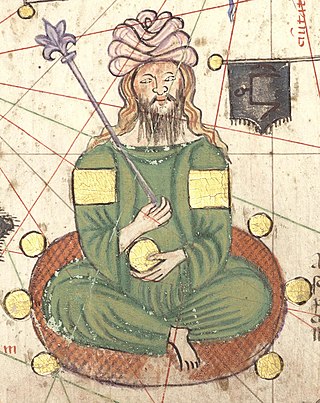
Jani Beg, also known as Janibek Khan, was Khan of the Golden Horde from 1342 until his death in 1357. He succeeded his father Öz Beg Khan.

Munkh Tumur or Möngke Temür was a son of Toqoqan Khan and Köchu Khatun of Oirat, daughter of Toralchi Küregen and granddaughter of Qutuqa Beki, and the grandson of Batu Khan. He was a khan of the Golden Horde, a division of the Mongol Empire in 1266–1280.

Tokhta was Khan of the Golden Horde from 1291 to 1312. He was a son of Mengu-Timur and a great-grandson of Batu Khan.

The Tokhtamysh–Timur war was fought from 1386 to 1395 between Tokhtamysh, khan of the Golden Horde, and the warlord and conqueror Timur, founder of the Timurid Empire, in the areas of the Caucasus Mountains, Turkestan and Eastern Europe. The battle between Amir Timur and Tokhtamysh played a key role in the decline of Mongol power over early Russian principalities.

The Venetian–Genoese Wars were four conflicts between the Republic of Venice and the Republic of Genoa which took place between 1256 and 1381. Each were resolved almost entirely through naval clashes and connected to each other by interludes during which episodes of piracy and violence between the two Italian trading communities in the Mediterranean Sea and the Black Sea were commonplace, in a "cold war" climate.

Tini Beg, also known as Dinibeg, was Khan of the Golden Horde from 1341 to 1342.

The Black Death was one of the most devastating pandemics in human history, resulting in the deaths of an estimated 75 to 200 million people in Eurasia, and peaking in Eurasia from 1321 to 1353. Its migration followed the sea and land trading routes of the medieval world. This migration has been studied for centuries as an example of how the spread of contagious diseases is impacted by human society and economics.

The second plague pandemic was a major series of epidemics of plague that started with the Black Death, which reached medieval Europe in 1346 and killed up to half of the population of Eurasia in the next four years. It followed the first plague pandemic that began in the 6th century with the Plague of Justinian, but had ended in the 8th century. Although the plague died out in most places, it became endemic and recurred regularly. A series of major epidemics occurred in the late 17th century, and the disease recurred in some places until the late 18th century or the early 19th century. After this, a new strain of the bacterium gave rise to the third plague pandemic, which started in Asia around the mid-19th century.
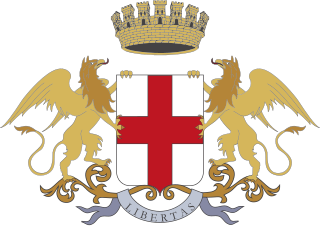
Giovanni di Murta was elected the second Doge of the Republic of Genoa after the resignation of Simone Boccanegra, on 25 December 1345. His dogate was dominated by his attempts to break the circle of political violence which had crippled the city over the past century and to reassert Genoese dominion over the Mediterranean colonies.
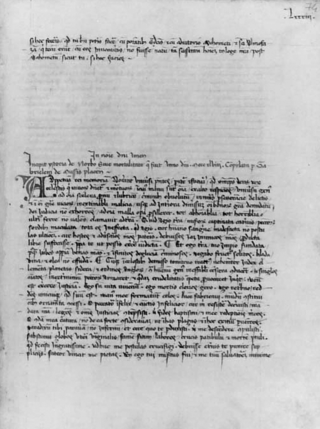
Gabriel de Mussis — in Italian, Gabriele de' Mussi — was a notary from Piacenza, Italy, who gave a vivid account of the start of the Black Death in the Black Sea city of Kaffa and its spread to Sicily and Piacenza. His account in Latin, entitled Istoria de Morbo sive Mortalitate quae fuit Anno Dni MCCCXLVIII, is preserved in a manuscript in the library of the University of Wroclaw.
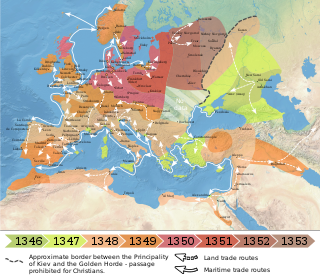
The Black Death was present in Italy between 1347-1348. Sicily and the Italian Peninsula was the first area in then Catholic Western Europe to be reached by the bubonic plague pandemic known as the Black Death, which reached the region by an Italian ship from the Crimea which landed in Messina in Sicily in October 1347.
The War of the Straits (1350-1355) was a third conflict fought in the series of the Venetian-Genoese wars. There were three causes for the outbreak of the war: the Genoese hegemony over the Black Sea, the capture by Genoa of Chios and Phocaea and the Latin war which caused the Byzantine Empire to lose control over the straits of the Black Sea, thus making it more difficult for the Venetians to reach the Asian ports.

Taydula Khatun was a queen consort of the Mongol Golden Horde as the wife of Öz Beg Khan and possibly Nawruz Beg Khan. She was also the mother of the khans Tini Beg and Jani Beg, and the grandmother of Berdi Beg. The favorite of her husband, she gained and retained a lasting importance during the reigns of her sons and grandson, and attempted to hold on to power by appointing the latter's successors.
The Genoese–Mongol Wars were a series of conflicts fought between the Republic of Genoa, the Mongol Empire and its successor states, most notedly the Golden Horde and Crimean Khanate. The wars were fought over control of trade and political influence in the Black Sea and Crimean peninsula during the 13th, 14th and 15th centuries.
